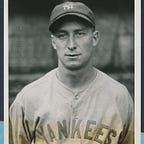Monday, May 23, 1927: Washington, D.C.
Youth. Lazzeri. And Lindbergh.
 Youth is the elixir of our time.
Youth is the elixir of our time.
Old men control the banks, they steer the giant corporations and institutions that run the country, and they choose when we go to war — but the fuel of America is youth.
As we travel the country, I feel it every time I get off the train. I feel it walking down almost every street. I feel it at night in the speakeasies and the ballrooms. I can feel it in the music — jazz is the sound of youth.
And now, thanks to a kid named Lindbergh, youth is literally in the air.
The world became a much smaller place on Saturday. All because of a 25-year-old — Icarus with wings that not even the sun could melt — who overnight became the most famous person on earth.
 The news landed in Cleveland at Dunn Field in the bottom of the seventh inning. It came over the wire in the press box. “Lindbergh’s landed in Paris!” someone shouted. Then someone else shouted it. Then someone else. Before long, the whole stadium was shouting it. 15,000 fans who had been cheering their home team spontaneously stood up, put their hands over their hearts and began singing “The Star-Spangled Banner.” All of the players joined in, singing as loudly and as proudly as we’d ever sung the anthem before, just like we sang it before the Great War. Then we all just started hugging one another and shaking hands.
The news landed in Cleveland at Dunn Field in the bottom of the seventh inning. It came over the wire in the press box. “Lindbergh’s landed in Paris!” someone shouted. Then someone else shouted it. Then someone else. Before long, the whole stadium was shouting it. 15,000 fans who had been cheering their home team spontaneously stood up, put their hands over their hearts and began singing “The Star-Spangled Banner.” All of the players joined in, singing as loudly and as proudly as we’d ever sung the anthem before, just like we sang it before the Great War. Then we all just started hugging one another and shaking hands.
With one single heroic and mythical feat the name Charles Lindbergh is now more famous even than the name Babe Ruth! And why not? The Babe may be able to hit baseballs farther than anyone ever thought possible, but this kid, by himself, just flew a small, one-man airplane from New York to Paris, in one giant leap.
3,600 miles straight.
In 33 hours and 30 minutes.
If he had landed on the moon the emotion of the moment couldn’t have been bigger.
The papers say that 100,000 French men and women, when they heard over the radio that his plane had been spotted off the coast of France around 10 p.m., dropped whatever they were doing and drove out to see the kid alight on the airfield in Le Bourget, just outside of Paris. They also say that when Lindbergh saw all the lights from the cars tangled in a five mile long traffic jam trying to get to the airfield, that for a few moments he wasn’t sure if he was headed for Le Bourget or a boulevard in Paris. The radio in our hotel this morning said that when the kid comes back to America, a million people are expected to greet him.
The world feels different.
The history of mankind has a new demarcation. There’s now “Before Lindbergh,” and “After Lindbergh.”
Just after the Great War, the Greenwich Village hotel owner Raymond Orteig — a friend of Schoolboy’s, of course — offered up $25,000 to the first team to fly between New York and Paris, or vice versa. In the past year 11 aviators have died trying — including some of the world’s most famous pilots, like the World War I ace, Charles Nungesser, who just three weeks ago was lost at sea — each man attempting to write his name in history.
But the kid had one thing those other pilots no longer had.
Youth.
Lindbergh was competing against teams of pilots, all of them older and more experienced, wealthy men flying together in bigger planes, packed with better equipment.
But this kid did it on his own, flying into the sky with nothing to weigh him down:
He did it without a navigator.
He did it without a radio.
He did it with just one engine.
Hell, 33 and a half hours over water and he didn’t even pack a lifeboat.
Youth.
That’s the one thing he was packing.
Fighting sleep for much of the time, he was surrounded only by water, sky, clouds and stars. The papers say that — depending on the weather, the cloud cover, and the wind — at times he flew as high as 10,000 feet and as low as just 10 feet over the waves. While he flew, he also was navigating — a task just as difficult as flying a plane — using only a compass and the stars, with maps spread out in front of him and a flashlight in his mouth.
Insanity.
But, then, this is the age of insanity — and the age of youth.
The kid wasn’t looking to write his name in the history books. Hell, youth doesn’t give a hoot about history.
He was looking to grab greatness by the throat and own it. And now he does.
 The Yankees got two injections of youth, in 1925 and 1926, when first Lou Gehrig, and then Tony Lazzeri and Mark Koenig joined the team full time.
The Yankees got two injections of youth, in 1925 and 1926, when first Lou Gehrig, and then Tony Lazzeri and Mark Koenig joined the team full time.
The way Gehrig slams the ball, everyone knew he was going to be a terror at the plate. Lazzeri, though, from the moment he put on pinstripes, was something special, not only at the plate but also in the field. Last year, as a 22-year-old rookie, he took command of the infield. It was something to watch.
Miller Huggins took a huge risk in the eyes of most baseball men and all the writers last season by starting the three youngsters — Gehrig (only 23), Lazzeri (only 22) and Koenig (only 21) — every day at first, second and short. But Huggins knew the W*p was something special and would be the key to keeping it all together. Sure enough, the kid took control right away. Dugan at 29 may have been the best defensive third baseman in the game but he instantly realized that Lazzeri was the natural leader of the Yankee infield.
As a pitcher who throws ground balls, it’s reassuring to have Dugan and Lazzeri behind me, especially Lazzeri. At the end of last year, Tony told me that when he’s in the field, every single game, every single inning, every single batter — before every single pitch — no matter how great the pressure of the situation, he chants to himself: “Hit. The. Fucking. Ball. To. me.”
(Gehrig and Koenig, before every pitch, I’m sure, are both silently chanting: “Hit. The. Fucking. Ball. To. Lazzeri. Please.”)
Tony’s played all over the infield: second, short and third. The other night on the train, Hoyt, Pennock, Shawkey and Art Fletcher, one of our coaches, were talking about Tony and they quickly came to the consensus that the W*p’s actually not the best second baseman in the league — he’s the best infielder, at any position. Fletcher, who was one of the game’s top shortstops before he retired in ’22, declared that Lazzeri’s the equal of any infielder he’s ever seen. Pennock and Shawkey both agreed with Fletch, and they’ve each played 15 years in the bigs. Dutch Ruether between drinks just shook his head and said, “That gu*nea makes plays nobody else can make — hell, he makes plays I didn’t think were possible.”
Like Ruth, Lazzeri’s a remarkable, natural athlete — he wanted to be a boxer, and if he’d stayed in the ring he’d probably have a belt by now — but he’s not great simply because he’s a natural. What really separates the W*p from the rest of us are his drive and his smarts. He knows what to do in every situation and is constantly calling it out to the other players on the field.
Lazzeri, like Lindbergh, grabs greatness by the throat. He’s got a competitive fire that burns inside him as white hot as any player, even Cobb. But because he’s not a bastard like Cobb, instead of engendering hatred, Lazzeri’s competitive drive commands respect.
Like Lindbergh, Lazzeri’s raw abilities shout “youth.” But he plays as if he were a 10-year veteran. No one’s ever seen anything like him.
 Tony grew up poor in San Francisco, and tough. He was booted out of school in his teens for constantly fighting. So he took up boxing. To make money, he went to work as a boilermaker, like his father, heating and hauling rivets — he still proudly carries his union card for San Fran Local №6 in his wallet. Between the boxing gym and the boilermaker’s furnace, his body was forged into a lean sculpted mass.
Tony grew up poor in San Francisco, and tough. He was booted out of school in his teens for constantly fighting. So he took up boxing. To make money, he went to work as a boilermaker, like his father, heating and hauling rivets — he still proudly carries his union card for San Fran Local №6 in his wallet. Between the boxing gym and the boilermaker’s furnace, his body was forged into a lean sculpted mass.
There are two guys on our team that no one in either league would ever want to mess with: Lazzeri and Bob Meusel. Silent Bob is 6-foot-3 and close to 200 pounds — he’s tough and he’s scary, because no one knows what’s going on inside his head. Tony is under 6 feet and less than 170 pounds, but his toughness is unquestioned, respected, and even feared.
When Tony was 17 and playing sandlot ball in San Francisco, he was signed by the Salt Lake City Bees of the Pacific Coast League. His fourth year in the league he mastered the curveball and hit over .350 with over 250 hits, over 200 RBIs and over 200 runs scored. The W*p also whacked 60 home runs — becoming the only man in professional baseball ever to hit 60.
One of our scouts, Bill Essick, saw Tony hit a couple of home runs in Salt Lake City and called Ed Barrow to get permission to sign the kid. Essick says Barrow’s reaction was to scoff, “The air out there is thin.” The scout’s rejoinder was perfect: “The air may be thin,” he said, “but the kid is solid.”
Last year, Tony was more than solid. In his rookie season he finished third in the American League in home runs, had over 100 RBIs and finished 10th in the MVP voting. Not one Yankee, though, could pick three players in our league, let alone nine, that we’d take ahead of Lazzeri.
Tony did have that infamous strike out in Game 7 of the World Series — but just one pitch before that he had come within a foot of a grand slam. It was just one of the breaks of the game, and even though the writers always bring it up, he hasn’t let the moment get to him, at least not outwardly.
I don’t understand why the New York press, in their desire to blame someone for blowing the series, landed on Tony rather than Ruth — it was the Babe who actually lost the game with the most ill-conceived goddamn base running since Fred Merkle’s Boner. The press also could have landed on Mark Koenig, whose error in Game 7 led to three unearned runs, and who had four errors in the series, in part because the Cardinals’ bench rattled him all series long. Maybe it’s because Lazzeri’s Italian, and the ink-stained crowd believe they can pick on him because they think he can’t read their papers.
The W*p’s brethren sure can read the papers, though. More and more Italians are showing up at the ballpark every day to come see Lazzeri play. And not just at Yankee stadium, but wherever we play — thousands of them are coming out. Even when we’re on the road we can hear them cheering loudly, and yelling, “Poosh ’em up, Tony!”
He’s their kid.
At 29 years old, I’m no longer anybody’s kid.
If I was a great player, I would be in my prime.
The game of baseball is no longer full of promise for me — what once was promise has been replaced by uncertainty.
On the field — when I can get on the field — I no longer look to grab greatness by the throat, if I ever really did. Instead, I look to be useful. It is, I have decided, a noble struggle of limited consequence for anyone but myself.
I still have faith in my abilities to play at this level, but I no longer have aspirations of greatness. While playing with the Yankees, I have learned what real greatness is.
Every day I see it up close, beginning of course with Ruth, whose greatness is so large that it is beyond exaggeration, so blinding that it is truly beyond comprehension. This season Gehrig’s greatness has been unveiled, his abilities suddenly breaking loose from the shackles of his personality. Lazzeri, Hoyt, Pennock and Silent Bob Meusel are all great players, too, full of ability and all, save Meusel, burning with a competitive drive and the desire to grab greatness by the throat.
At times, because I toil on the mound, I may be standing center stage, but I’m no more than a bit player. For me, more than anything else, the game — which I still love — now is about hanging on. At 29, I’m playing a game that makes me feel old and young at the same time.
- 1927 Yankees
- Bill Essick
- LOU Gehrig
- TONY Lazzeri
- Charles Lindbergh
- SILENT BOB Meusel
- Charles Nungesser
- Raymond Orteig
- Merkle’s Boner
- NEW YORK TIMES, May 22, 1927: “Crowd Roars [Lindbergh’s] Thunderous Welcome”
- Box Score: Cardinals 3 vs. Yankees 2 (1926 World Series, Game 7)
- May 21, 1927: “Yanks Lose In 12th On Pass By Moore”. New York Times article and Box Score.
“You Can’t Get Pissed Off At Ruth. (But You Can Get Pissed Off at Koenig).”
In Myles’s first start of the season everything goes well. Until it doesn’t.
“No rational human being can get pissed at anything the Babe does on the field. Ruth single-handedly wins more games than any other player in the league. He plays hard every play — he’s as competitive as anyone else who’s ever put on a uniform — and he plays smart. When he does make a mistake — even his catastrophic base running blunder in the bottom of the ninth, that cost us Game 7 of last year’s World Series — you simply cannot get pissed at Ruth.
But sweet Jesus Christ, it sure is easy to get pissed at Mark Koenig.”

